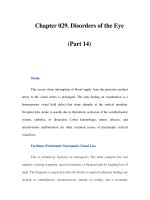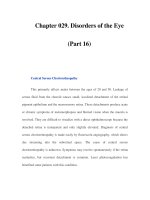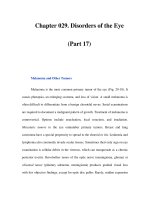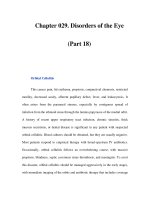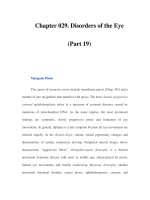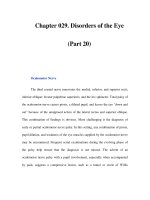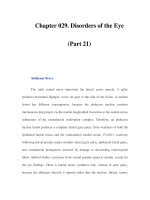Chapter 029. Disorders of the Eye (Part 19) ppsx
Bạn đang xem bản rút gọn của tài liệu. Xem và tải ngay bản đầy đủ của tài liệu tại đây (13.76 KB, 5 trang )
Chapter 029. Disorders of the Eye
(Part 19)
Myogenic Ptosis
The causes of myogenic ptosis include myasthenia gravis (Chap. 381) and a
number of rare myopathies that manifest with ptosis. The term chronic progressive
external ophthalmoplegia refers to a spectrum of systemic diseases caused by
mutations of mitochondrial DNA. As the name implies, the most prominent
findings are symmetric, slowly progressive ptosis and limitation of eye
movements. In general, diplopia is a late symptom because all eye movements are
reduced equally. In the Kearns-Sayre variant, retinal pigmentary changes and
abnormalities of cardiac conduction develop. Peripheral muscle biopsy shows
characteristic "ragged-red fibers." Oculopharyngeal dystrophy is a distinct
autosomal dominant disease with onset in middle age, characterized by ptosis,
limited eye movements, and trouble swallowing. Myotonic dystrophy, another
autosomal dominant disorder, causes ptosis, ophthalmoparesis, cataract, and
pigmentary retinopathy. Patients have muscle wasting, myotonia, frontal balding,
and cardiac abnormalities.
Neurogenic Ptosis
This results from a lesion affecting the innervation to either of the two
muscles that open the eyelid: Müller's muscle or the levator palpebrae superioris.
Examination of the pupil helps to distinguish between these two possibilities. In
Horner's syndrome, the eye with ptosis has a smaller pupil and the eye movements
are full. In an oculomotor nerve palsy, the eye with the ptosis has a larger, or a
normal, pupil. If the pupil is normal but there is limitation of adduction, elevation,
and depression, a pupil-sparing oculomotor nerve palsy is likely (see next section).
Rarely, a lesion affecting the small, central subnucleus of the oculomotor complex
will cause bilateral ptosis with normal eye movements and pupils.
Double Vision (Diplopia)
The first point to clarify is whether diplopia persists in either eye after
covering the opposite eye. If it does, the diagnosis is monocular diplopia. The
cause is usually intrinsic to the eye and therefore has no dire implications for the
patient. Corneal aberrations (e.g., keratoconus, pterygium), uncorrected refractive
error, cataract, or foveal traction may give rise to monocular diplopia.
Occasionally it is a symptom of malingering or psychiatric disease. Diplopia
alleviated by covering one eye is binocular diplopia and is caused by disruption of
ocular alignment. Inquiry should be made into the nature of the double vision
(purely side-by-side versus partial vertical displacement of images), mode of
onset, duration, intermittency, diurnal variation, and associated neurologic or
systemic symptoms. If the patient has diplopia while being examined, motility
testing should reveal a deficiency corresponding to the patient's symptoms.
However, subtle limitation of ocular excursions is often difficult to detect. For
example, a patient with a slight left abducens nerve paresis may appear to have
full eye movements, despite a complaint of horizontal diplopia upon looking to the
left. In this situation, the cover test provides a more sensitive method for
demonstrating the ocular misalignment. It should be conducted in primary gaze,
and then with the head turned and tilted in each direction. In the above example, a
cover test with the head turned to the right will maximize the fixation shift evoked
by the cover test.
Occasionally, a cover test performed in an asymptomatic patient during a
routine examination will reveal an ocular deviation. If the eye movements are full
and the ocular misalignment is equal in all directions of gaze (concomitant
deviation), the diagnosis is strabismus. In this condition, which affects about 1%
of the population, fusion is disrupted in infancy or early childhood. To avoid
diplopia, vision is suppressed from the nonfixating eye. In some children, this
leads to impaired vision (amblyopia, or "lazy" eye) in the deviated eye.
Binocular diplopia occurs from a wide range of processes: infectious,
neoplastic, metabolic, degenerative, inflammatory, and vascular. One must decide
if the diplopia is neurogenic in origin or due to restriction of globe rotation by
local disease in the orbit. Orbital pseudotumor, myositis, infection, tumor, thyroid
disease, and muscle entrapment (e.g., from a blowout fracture) cause restrictive
diplopia. The diagnosis of restriction is usually made by recognizing other
associated signs and symptoms of local orbital disease in conjunction with
imaging.
Myasthenia Gravis
(See also Chap. 381) This is a major cause of diplopia. The diplopia is often
intermittent, variable, and not confined to any single ocular motor nerve
distribution. The pupils are always normal. Fluctuating ptosis may be present.
Many patients have a purely ocular form of the disease, with no evidence of
systemic muscular weakness. The diagnosis can be confirmed by an IV
edrophonium injection or by an assay for antiacetylcholine receptor antibodies.
Negative results from these tests do not exclude the diagnosis. Botulism from food
or wound poisoning can mimic ocular myasthenia.
After restrictive orbital disease and myasthenia gravis are excluded, a lesion
of a cranial nerve supplying innervation to the extraocular muscles is the most
likely cause of binocular diplopia.

